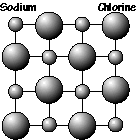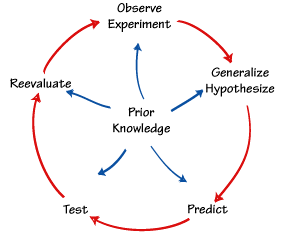SLU
EAS-A193 Class Notes
An Introduction to
Scientific Study
Scientific Study
|
SLU EAS-A193 Class Notes |
Scientific Study |
We assume that we can uncover and understand natural laws and we rely on:
Carl Sagan (1934-1996) said it most simply, beyond keeping an open, but skeptical mind, the real trick of science is to "really think of something".
The essence of science is asking and answering questions, and then digging deep into the answers to expose more questions.
Using science, we have improved the standard of living, expanded our ability to travel and communicate, and enhanced our ability to grow and provide food for large populations. We have conquered terrible diseases, explored the universe, and learned an extraordinary amount in a very short time. Why can we do this?
In science, all of our answers are framed as hypotheses, some are more established than others, some probably are imperfect, and any would be abandoned if contradicting observations were produced tomorrow.
The willingness to re-evaluate and to challenge established ideas provides a self-correcting error-removal mechanism in science and is the most important reason for our success with science.
Science is a means of studying the physical world, it is not an approach that can answer all important questions. Those who offer science as the answer to all questions are as mislead as those who blame science for all our problems. Fundamental questions about art, religion, the meaning of life, and our personal lives are simply outside the realm of science.
Some people believe that since at times we revise our ideas in science, scientific knowledge is no different than myths or legends, and our knowledge does not progress.
Nonsense. We may refine our ideas often and change them completely occasionally, but the success of science is difficult to question. There are different levels of certainty in scientific knowledge, and there are clear examples of progress:
That sure looks like progress to me.
We can describe scientific knowledge a number of ways, the classification below if from a book H.H. Bauer.
I will discuss established and frontier Earth science in this course since much of the excitement is at the frontier.
Although often overlooked, how we know is a very interesting subject for reflection. The idea is best illustrated with an example, and we'll use one from Carl Sagan's essay "Reflections on a Grain of Salt", published in Broca's Brain.
Sagan asks if we can know a grain of salt. Let's see.
In a typical salt grain, there are about 10,000,000,000,000,000 atoms of sodium and chlorine. We'll make the problem easier and not worry about chemical bonding and other interesting details, but we must acknowledge that to truly understand a grain of salt, we must at least know the positions of the atoms in the grain. How much information can we store?
Our brains have about 10^11 neurons, each with about 10^3 dendrites. Using these numbers to represent how much information our brains can store; we find that we really can only retain the positions of 1% (10^14 / 10^16 x 100%) of the atoms in a single grain of salt. If we needed to store our understanding of nature in this manner, we would be in deep trouble since we couldnt handle a grain of salt!
|
But we can know a grain of salt. We can because there are rules that simplify the requirements of "knowing". In this particular case, the positions of sodium and chlorine atoms are organized into an ordered array and we only need to store about 10 bits of information to reproduce the structure of a grain of salt. |
 |
In a way, in science we look for patterns or unity in processes. Consider the following natural phenomena
These are all examples of waves, and the mathematics that we use to analyze and exploit these phenomena is uniform - the Wave Equation".
That each of these processes is described by very similar laws found, nature didnt have to be that way, but we are very fortunate that it is. In fact, we rely on is form of simplicity.
So, we learn about nature by uncovering the patterns or rules that govern certain processes. In addition to presuming the existence of these rules, scientists make another assumption called the principle of universality*:
The laws of nature that we discover here and now are true throughout the universe and have been in effect for all time.
For much of the history of science, this principle was unknown, and if espoused, would have been considered heretical. However, we have evidence to support the hypothesis.
*Read James Trefil's book, Reading the Mind of God, for more details.
In the west, our scientific tradition began with the Greeks, who believed that the key to understanding nature was reason. They thought observation distracted study from the true nature of an object, and hence did not base their work on empirical evidence.
They also believed that the laws of nature were different for objects in the heavens, and objects on Earth.
For nearly 2000 years after Aristotle, study of nature was dominated by the idea that natural processes were in different parts of the universe.
In 1666, Isaac Newton had a flash of insight and hypothesized that Aristotle and the Greeks were wrong and that the same laws governed the falling of an apple, and the orbit of the moon.
This was quite an intuitive leap, before this time, people thought the similarity between the apple and the moon was equivalent to the similarity between the number five and the color green.
Fortunately, Newton was a brilliant mathematician and was able to explain the motion of the moon, planets, and objects on Earth with a uniform system of laws motion and gravity.
These laws were consistent with the observations, which by that time had assumed their prominent importance in scientific study.
After Newton, others extended the idea of a universal set of laws farther and farther into the universe.
Halley and his comet provided evidence that Netwons laws extended applied outside the planets and included all of the solar system.
William Herschel discovered evidence in the orbit of binary star systems that Newtons laws extended to other star systems.
When Einstein came along, he looked at some rather unusual situations: traveling near the speed of light, and very massive systems. He extended Newton's "laws" and constructed his theories of special and general relativity to apply in both the "usual" and "unusual" circumstances.
While the physicists were investigating ever outward from Earth, a group of scientists called geologists were making a similar effort to understand the nature of rocks on and within Earth. By careful and extensive observation of rocks and present-day natural processes, they were able to infer that Earth was very old, and in fact, the "laws" of nature had been operating for a very long time. In geology, the Principle of Universality is called the Uniformitarianism, and is summarized in the Charles Lyells statement,
"The present is the key to the past".
A general, but not universal, model for scientific problem solving is
The key points are observation and reevaluation, any theory must be modified if accurate and reliable observations conflict with the idea. We can think scientific reserach and a continuing problem solving cycle

Reasons we support research
The boundary between basic research and applied research is often fuzzy, its hard to predict when advances in one will spur advances in the others
Most basic research in the US is funded by our tax dollars and we watch our investments wisely and keep the competition for funding stiff. Proposals for research are peer-reviewed to insure that only qualified researchers and interesting and important problems receive a share of our money. We require publication of the results, and these publications are also peer-reviewed before they are published. Peer review is a cornerstone of modern science, and often what distinguishes legitimate research from junk science or pseudoscience.
Junk science is simply bad science. Sometimes it is unintentional but at times it is deliberate fraud. An example illustrates the idea best. In 1989, two scientists, Pons and Fleishmann called a press conference to announce their discovery of cold fusion. They skipped the usual peer-review process, went straight to the media, and then straight to Congress seeking millions of dollars to support their research. Fortunately, before they received a dollar of our money, other scientists around the world checked their original work and showed that it was incorrect and irreproducible. Pons and Fleishmann skirted the established scientific community in a rush for research money, and they were wrong.
Pseudoscience is work that is deliberately passed off as scientific but does not meet the requirements for science. Examples are creationism, astrology, belief crystal power, reincarnation, etc.
Usually, pseudoscience practitioners violate one of the following aspects of legitimate scientific study:
The way to smoke out junk science and pseudoscience is to think critically and demand answers to your questions.